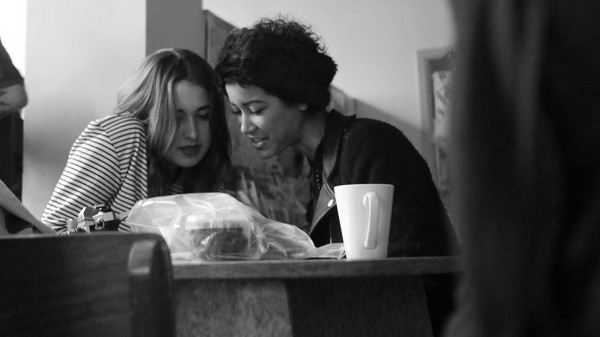East Anglia seems rather tame today. This was the view, a few yards outside our door, last weekend.
Author Archives: qsf
Pavlovian Titillation
One of the reasons I am sometimes envious of design/media companies is that they can get away with names that, in other sectors, would cause people at least to snigger, if not positively guffaw.
Can you imagine a law firm, or a steel manufacturing plant, deciding to name itself The Marmalade? Even in the technology world that I tend to inhabit, where many companies, let’s face it, have some pretty silly names, I’m still impressed.
But you can get away with such names if you have other ways to make people take you seriously. And Seb Wills pointed me at this Fast Company post which suggests that The Marmalade may not find that too hard. The embedded video clip, showcasing some of their work, contains some very impressive sequences.
LinkedOut?
Yesterday evening, I accidentally tapped a button on my iPad screen. At least, I guess I must have done, because emails started coming back from all those who had accepted my LinkedIn invitation. Eh?
Yes, it turns out that I had accidentally spammed a couple of hundred people asking for a connection. I think it was everyone in my Gmail contacts who was on LinkedIn but not already connected to me. I know you can do such things, but I would never dream of performing so crass an operation deliberately.
And this is all very embarrassing. There are some I know well and would be delighted to connect to: I just hadn’t got around to it yet. But there are many more whom I scarcely know at all, and I can just imagine them scratching their heads and making the same sort of face that I make when complete strangers ask me for a connection. And then there are those I know in a completely different social context: the wife of a casual acquaintance who is probably wondering why on earth I connected to her and not her husband…
All of which makes me ponder: have I ever actually had any benefit from my LinkedIn account (which I’ve had almost since the service started)? I can’t think of any. There have been one or two people who have sent me useful messages, but I’m not hard to find elsewhere on the net, and frankly would much prefer to receive such communications by email. And then there was all that endorsement craziness a little while back.
No, the only positive thing I can really say about LinkedIn is that it doesn’t annoy me as much as Facebook. But then, I do occasionally get some benefit from Facebook.
So I suspect that the right thing to do is to close my account. And yet, as I come to that conclusion, I think of all those distant acquaintances who, having received my annoying message, sigh and say, “Oh well, I suppose I’d better link to him”, and click the button, only to be told that my account is no longer there, so I’d pestered them in vain. Argh!
You see, I can’t win. Social gaffes threaten at every turn… Help! I’m LockedIn…
The iPad will be my undoing
Gosh, it’s easy to miss this one:
Finding the Undo and Redo keys on the iPad
I’ve been using the vigorous-shake-to-undo feature when I’m working in apps which don’t have an Undo button, but it isn’t always convenient. Especially late at night when I’m trying not to wake Rose…
Sign of the times
After a weekend clear-out, we’re giving away a couple of dumbbell-type exercise weights, and an old HP Deskjet printer, on our local Freecycle list.
Seven people immediately expressed an enthusiastic desire for the gym accessories.
Nobody was interested in the miracle of modern printing technology.
The food is best from Budapest
This is, in my opinion, some of the finest salami yet created by mankind. I’m sure it’s the finest at my local Waitrose, anyway. It’s… well… creamy.
If you’re a salami enthusiast, ask yourself when you last described one as creamy. If it wasn’t recently, give this a try. Goes nicely with mozzarella in a salad.
The Googlehome?
My friend Frazer points out that the manufacturers of screen wash fluid had better start looking for a new business, because, with self-driving cars, we soon won’t need windscreen wipers. And with no rear-view mirrors, where will we hang the fluffy dice? Actually, Frazer has some keen insights into the massive changes that driverless cars will eventually bring to society.
Richard and I, discussing our hopes for this future, realised that what we really wanted was a driverless campervan or motorhome. Just imagine, you can all sit around and have a cup of tea en route. Or, if you prefer, a glass of wine. And then go to bed. And in the morning, you wake up in the Alps and take the dog out for a walk. If you need a car, to get around while you’re there, you can call one to wherever you’re parked. But if you have a car of your own, and you want to take yours along, you can just tell it to follow you there.
Now, this is an important new market, because one of the things that driverless cars will bring is dramatically-reduced car ownership. Cars sit idle in the street for so much of the time, just so that they’re around when you need them. But when an iPhone app can call any nearby car to you at any time, they’ll be much more efficiently used, and you’re much less likely to need one of your own. Having to find parking in city centres will be a thing of the past, and residential streets will be freed of so much clutter. All good news.
Unless, of course, you’re a car manufacturer. If car ownership goes down by a factor of two, three, four… who knows?… you’ll need a new source of revenue. And I think your motorhome/campervan, decked out the way you like it, is a very personal thing – it’s something you’ll still want to own. And something a lot more people will want to own in this future.
So I’d like to offer my services as a consultant and beta-tester for Google, and all those auto manufacturers, who are now slapping their foreheads as they realise that… of course! The key to their future is in the mobile, self-driving, holiday cottage…
© Copyright Quentin Stafford-Fraser







Recent Comments